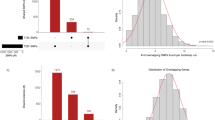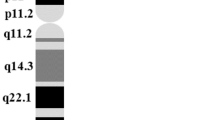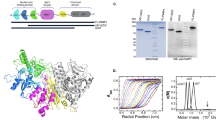Abstract
Resolving the underlying functional mechanism to a given genetic association has proven extremely challenging. However, the strongest associated type 2 diabetes (T2D) locus reported to date, TCF7L2, presents an opportunity for translational analyses, as many studies in multiple ethnicities strongly point to SNP rs7903146 in intron 3 as being the causal variant within this gene. We carried out oligo pull-down combined with mass spectrophotometry (MS) to elucidate the specific transcriptional machinery across this SNP using protein extracts from HCT116 cells. We observed that poly (ADP-ribose) polymerase 1 (PARP-1) is by far the most abundant binding factor. Pursuing the possibility of a feedback mechanism, we observed that PARP-1, along with the next most abundant binding proteins, DNA topoisomerase I and ATP-dependent RNA helicase A, dimerize with the TCF7L2 protein and with each other. We uncovered further evidence of a feedback mechanism using a luciferase reporter approach, including observing expression differences between alleles for rs7903146. We also found that there was an allelic difference in the MS results for proteins with less abundant binding, namely X-ray repair cross-complementing 5 and RPA/p70. Our results point to a protein complex binding across rs7903146 within TCF7L2 and suggests a possible mechanism by which this locus confers its T2D risk.
Similar content being viewed by others
Log in or create a free account to read this content
Gain free access to this article, as well as selected content from this journal and more on nature.com
or
References
Sladek R, Rocheleau G, Rung J et al: A genome-wide association study identifies novel risk loci for type 2 diabetes. Nature 2007; 445: 881–885.
Wellcome Trust Case Control Consortium: Genome-wide association study of 14 000 cases of seven common diseases and 3000 shared controls. Nature 2007; 447: 661–678.
Saxena R, Voight BF, Lyssenko V et al: Genome-wide association analysis identifies loci for type 2 diabetes and triglyceride levels. Science 2007; 316: 1331–1336.
Zeggini E, Weedon MN, Lindgren CM et al: Replication of genome-wide association signals in UK samples reveals risk loci for type 2 diabetes. Science 2007; 316: 1336–1341.
Scott LJ, Mohlke KL, Bonnycastle LL et al: A genome-wide association study of type 2 diabetes in Finns detects multiple susceptibility variants. Science 2007; 316: 1341–1345.
Grant SF, Thorleifsson G, Reynisdottir I et al: Variant of transcription factor 7-like 2 (TCF7L2) gene confers risk of type 2 diabetes. Nat Genet 2006; 38: 320–323.
Zeggini E, McCarthy MI : TCF7L2: the biggest story in diabetes genetics since HLA? Diabetologia 2007; 50: 1–4.
Weedon MN : The importance of TCF7L2. Diabet Med 2007; 24: 1062–1066.
Clevers H : Wnt/beta-catenin signaling in development and disease. Cell 2006; 127: 469–480.
Yi F, Brubaker PL, Jin T : TCF-4 mediates cell type-specific regulation of proglucagon gene expression by beta-catenin and glycogen synthase kinase-3beta. J Biol Chem 2005; 280: 1457–1464.
Korinek V, Barker N, Moerer P et al: Depletion of epithelial stem-cell compartments in the small intestine of mice lacking Tcf-4. Nat Genet 1998; 19: 379–383.
da Silva Xavier G, Loder MK, McDonald A et al: TCF7L2 regulates late events in insulin secretion from pancreatic islet beta-cells. Diabetes 2009; 58: 894–905.
Loder MK, da Silva Xavier G, McDonald A, Rutter GA : TCF7L2 controls insulin gene expression and insulin secretion in mature pancreatic beta-cells. Biochem Soc Trans 2008; 36: 357–359.
Kaminska D, Kuulasmaa T, Venesmaa S et al: Adipose tissue TCF7L2 splicing is regulated by weight loss and associates with glucose and fatty acid metabolism. Diabetes 2012; 61: 2807–2813.
Boj SF, van Es JH, Huch M et al: Diabetes risk gene and Wnt effector Tcf7l2/TCF4 controls hepatic response to perinatal and adult metabolic demand. Cell 2012; 151: 1595–1607.
Helgason A, Palsson S, Thorleifsson G et al: Refining the impact of TCF7L2 gene variants on type 2 diabetes and adaptive evolution. Nat Genet 2007; 39: 218–225.
Palmer ND, Hester JM, An SS et al: Resequencing and analysis of variation in the TCF7L2 gene in African Americans suggests that SNP rs7903146 is the causal diabetes susceptibility variant. Diabetes 2011; 60: 662–668.
Maller JB, McVean G, Byrnes J et al: Bayesian refinement of association signals for 14 loci in 3 common diseases. Nat Genet 2012; 44: 1294–1301.
Helgason A, Palsson S, Thorleifsson G et al: Refining the impact of TCF7L2 gene variants on type 2 diabetes and adaptive evolution. Nat Genet 2007; 39: 218–225.
Idogawa M, Yamada T, Honda K, Sato S, Imai K, Hirohashi S : Poly(ADP-ribose) polymerase-1 is a component of the oncogenic T-cell factor-4/beta-catenin complex. Gastroenterology 2005; 128: 1919–1936.
Tulin A, Chinenov Y, Spradling A : Regulation of chromatin structure and gene activity by poly(ADP-ribose) polymerases. Curr Top Dev Biol 2003; 56: 55–83.
Kraus WL, Lis JT : PARP goes transcription. Cell 2003; 113: 677–683.
Szabo C, Zanchi A, Komjati K et al: Poly(ADP-Ribose) polymerase is activated in subjects at risk of developing type 2 diabetes and is associated with impaired vascular reactivity. Circulation 2002; 106: 2680–2686.
Ilnytska O, Lyzogubov VV, Stevens MJ et al: Poly(ADP-ribose) polymerase inhibition alleviates experimental diabetic sensory neuropathy. Diabetes 2006; 55: 1686–1694.
Li F, Drel VR, Szabo C, Stevens MJ, Obrosova IG : Low-dose poly(ADP-ribose) polymerase inhibitor-containing combination therapies reverse early peripheral diabetic neuropathy. Diabetes 2005; 54: 1514–1522.
Obrosova IG, Li F, Abatan OI et al: Role of poly(ADP-ribose) polymerase activation in diabetic neuropathy. Diabetes 2004; 53: 711–720.
Pieper AA, Brat DJ, Krug DK et al: Poly(ADP-ribose) polymerase-deficient mice are protected from streptozotocin-induced diabetes. Proc Natl Acad Sci USA 1999; 96: 3059–3064.
Yochum GS, McWeeney S, Rajaraman V, Cleland R, Peters S, Goodman RH : Serial analysis of chromatin occupancy identifies beta-catenin target genes in colorectal carcinoma cells. Proc Natl Acad Sci USA 2007; 104: 3324–3329.
Duval A, Rolland S, Tubacher E, Bui H, Thomas G, Hamelin R : The human T-cell transcription factor-4 gene: structure, extensive characterization of alternative splicings, and mutational analysis in colorectal cancer cell lines. Cancer Res 2000; 60: 3872–3879.
Pomerantz MM, Ahmadiyeh N, Jia L et al: The 8q24 cancer risk variant rs6983267 shows long-range interaction with MYC in colorectal cancer. Nat Genet 2009; 41: 882–884.
Tuupanen S, Turunen M, Lehtonen R et al: The common colorectal cancer predisposition SNP rs6983267 at chromosome 8q24 confers potential to enhanced Wnt signaling. Nat Genet 2009; 41: 885–890.
Sur IK, Hallikas O, Vaharautio A et al: Mice lacking a Myc enhancer that includes human SNP rs6983267 are resistant to intestinal tumors. Science 2012; 338: 1360–1363.
Frayling TM, Colhoun H, Florez JC : A genetic link between type 2 diabetes and prostate cancer. Diabetologia 2008; 51: 1757–1760.
Lebedeva NA, Rechkunova NI, Agama K, Pommier Y, Lavrik OI : Interaction of DNA topoisomerase 1 with DNA intermediates and proteins of base excision repair. Biochemistry (Mosc) 2009; 74: 1278–1284.
Malanga M, Althaus FR : Poly(ADP-ribose) reactivates stalled DNA topoisomerase I and Induces DNA strand break resealing. J Biol Chem 2004; 279: 5244–5248.
Weidensdorfer D, Stohr N, Baude A et al: Control of c-myc mRNA stability by IGF2BP1-associated cytoplasmic RNPs. RNA 2009; 15: 104–115.
Cordin O, Banroques J, Tanner NK, Linder P : The DEAD-box protein family of RNA helicases. Gene 2006; 367: 17–37.
Gaulton KJ, Nammo T, Pasquali L et al: A map of open chromatin in human pancreatic islets. Nat Genet 2010; 42: 255–259.
Zhao J, Schug J, Li M, Kaestner KH, Grant SF : Disease-associated loci are significantly over-represented among genes bound by transcription factor 7-like 2 (TCF7L2) in vivo. Diabetologia 2010; 53: 2340–2346.
Taccioli GE, Gottlieb TM, Blunt T et al: Ku80: product of the XRCC5 gene and its role in DNA repair and V(D)J recombination. Science 1994; 265: 1442–1445.
Roberts SA, Strande N, Burkhalter MD et al: Ku is a 5'-dRP/AP lyase that excises nucleotide damage near broken ends. Nature 2010; 464: 1214–1217.
Mason AC, Haring SJ, Pryor JM, Staloch CA, Gan TF, Wold MS : An alternative form of replication protein a prevents viral replication in vitro. J Biol Chem 2009; 284: 5324–5331.
Kemp MG, Mason AC, Carreira A et al: An alternative form of replication protein a expressed in normal human tissues supports DNA repair. J Biol Chem 2010; 285: 4788–4797.
Savic D, Park SY, Bailey KA, Bell GI, Nobrega MA : In vitro scan for enhancers at the TCF7L2 locus. Diabetologia 2013; 56: 121–125.
Acknowledgements
A summary of the findings can be found at the TCF7L2 gene variant database located at: http://databases.lovd.nl/shared/variants/0000023424. This work was supported by the Institutional Development Funds from the Children’s Hospital of Philadelphia and an award from the Pennsylvania Department of Health. The University of Pennsylvania Proteomics Core is supported by NIH grants P30 CA016520 (Abramson Cancer Center) and P30 ES013508-04 (Center of Excellence in Environmental Toxicology).
Author information
Authors and Affiliations
Corresponding author
Ethics declarations
Competing interests
The authors declare no conflict of interest.
Additional information
Author conributions
QX, SD, CXY, MEJ and SFAG researched data. QX and SFAG wrote manuscript. SD, CXY and MEJ reviewed/edited manuscript.
Supplementary Information accompanies this paper on European Journal of Human Genetics website
Supplementary information
Rights and permissions
About this article
Cite this article
Xia, Q., Deliard, S., Yuan, CX. et al. Characterization of the transcriptional machinery bound across the widely presumed type 2 diabetes causal variant, rs7903146, within TCF7L2. Eur J Hum Genet 23, 103–109 (2015). https://doi.org/10.1038/ejhg.2014.48
Received:
Revised:
Accepted:
Published:
Issue date:
DOI: https://doi.org/10.1038/ejhg.2014.48
This article is cited by
-
Polymorphic genetic markers and how they are associated with clinical and metabolic indicators of type 2 diabetes mellitus in the Kazakh population
Journal of Diabetes & Metabolic Disorders (2021)
-
Complex patterns of direct and indirect association between the transcription Factor-7 like 2 gene, body mass index and type 2 diabetes diagnosis in adulthood in the Hispanic Community Health Study/Study of Latinos
BMC Obesity (2018)
-
Genetic variants associated with gestational diabetes mellitus: a meta-analysis and subgroup analysis
Scientific Reports (2016)
-
The type 2 diabetes presumed causal variant within TCF7L2 resides in an element that controls the expression of ACSL5
Diabetologia (2016)



